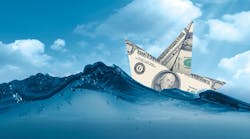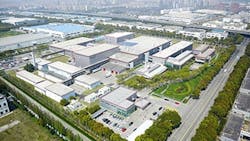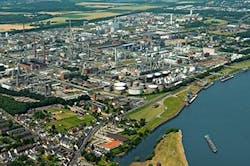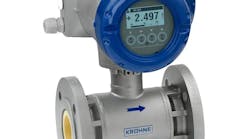Several chemical makers featured among the 106 companies that received the top ranking in the last Carbon Disclosure Project (CDP) Water Security “A” List (see: “Water Security: Some Chemical Companies Get an ‘A’”). The submissions of AstraZeneca, Bayer, BASF, Novartis, Air Liquide, Braskem, GSK and PTT to CDP provide a perspective on the different ways that firms at the forefront of water stewardship calculate water costs throughout their processes — and how these calculations are evolving.
Price Not The Issue
In its CDP entry, AstraZeneca, Cambridge, U.K., says it doesn’t use an internal price on water and doesn’t anticipate doing so within the next two years.
“We don’t believe water pricing would have a material impact on our water stewardship activities. We prioritize funding to improve efficiencies in water stressed areas, looking beyond financial returns on investment. For example, water is very cheap at our site in Wuxi, China, (Figure 1), so water efficiencies here offer poor return on investment, but we recognize, as a site in an area where water issues are a concern, investments are important to improve site resilience. At this site, we’ve invested in water audits and a number of efficiency projects,” the entry states.
The company performs water audits at high priority sites to identify significant water reduction projects, notes Sarah Argoud, natural resources lead for water and waste, AstraZeneca, Alderley Park, U.K.
“The project proposals identified during these audits are submitted as candidates for funding by a centralized investment fund. Spending from this fund is intended to reduce our site footprint of GHG [greenhouse gases], energy, waste and water to reach our long-term targets,” she adds.
Several factors influence the outcome of the selection process, including the expected overall footprint and expected lifetime savings of natural resource use, ease of execution, and the budget and expected payback of the project.
Last year, AstraZeneca invested $19 million from the fund, up from $15 million in 2019.
Argoud explains that the Wuxi efficiency project focuses on rainwater collection: “It involves collection into temporary storage wells with any overflow returning to the city water system. The water from the wells is treated and stored for ultimate reuse at the site. The savings realized is 3,500 m3/y.”
To better understand the risks for its sites and to help prioritize them, the company uses the World Wildlife Fund (WWF) Water Risk Filter tool (https://waterriskfilter.panda.org), she explains.
Developed by the WWF and the German Development Finance Institution, Cologne, it enables users to explore, assess, value and respond to water risks. Its latest release, Version 5.0, also provides scenarios of water risks for 2030 and 2050, integrating climate and socio-economic changes in three different pathways.
No Internal Price Either
In its CDP submission, Bayer, Leverkusen, Germany, says it doesn’t put an internal price on water for its sites such as the one in Dormagen, Germany (Figure 2) — but adds that it currently is exploring its water valuation practices.
Figure 1. Chinese site has seen investments in water audits and efficiency projects even though the local cost of water is low. Source: AstraZeneca.
“Bayer has analyzed the possibility to introduce an internal price of water as a possible tool to favor green investments. We came to the conclusion that an internal price on water is currently not meaningful for Bayer. Yet, we constantly revisit our analysis and conclusions in order to adapt to continuous developments and change,” the company notes.
The rationale for this approach, it says, is that attributing financial value to the materiality of water risk is an emerging field: “Upon make-or-buy assessments, internal water prices can bias the profitability of investments, thereby leading to unjustified outsourcing. In addition, due to specifics of our business, an internal price on water is not meaningful for Bayer and, hence, not a preferred tool to favor green investments.”
Contrasting Approach
According to its CDP submission, BASF, Ludwigshafen, Germany, does evaluate the value of water. This is based on a site-specific costs for the provision of water and disposal of wastewater. New investment decisions take into account the cost of water and wastewater. This, in turn, depends on current and future local situations based on a forecast of water availability and associated costs.
One of the valuation tools BASF uses to achieve this is PwC’s Total Impact Measurement and Management (TIMM) framework (http://pwc.to/3bbV2L9). It is designed to help users value the social, environmental and economic impacts of their activities and, so, compare the total impacts of their strategies and investment choices.
For BASF, this generates a “value to society” figure that includes data from the downstream supply chain, its own operations and customers.
The company calculates a figure for environmental impact of water use using a water stress index (WSI) that considers consumption at different sites and respective local water stress levels.
“The overall goal is to identify and initiate measures which result in achieving these objectives. This can be done in several ways. At BASF, we use several techniques, but not the ‘true cost’ approach,” says a spokeswoman.
One of these is sustainable water management. “A detailed analysis of our water use at all our production sites in water stress areas and our Verbund [integrated] sites identifies improvement options. The company is applying the European Water Stewardship Standard and is a member of the global Alliance for Water Stewardship,” adds the spokeswoman.
The company participation with the CDP also is important, serving as an opportunity to offer transparency regarding water-related issues. “It creates new communication pathways and provides important feedback for BASF to streamline processes and adapt our strategy,” she notes.
Figure 2. Bayer doesn’t apply an internal price to water used at site but that could change. Source: Bayer AG.
A third technique is operational excellence. This strategy incentivizes investments in water efficiency projects, among others.
The spokeswoman cites an example of the implementation of the company’s continuous sustainable water-management strategy at its integrated complex in Ludwigshafen. A new recooling plant started up in July 2020 that’s part of the company’s “Climate Resilience — Cooling” measures. These were launched in the wake of the extremely low water levels in 2018 to make the Ludwigshafen site more resilient against extreme climatic conditions.
“BASF also continuously monitors the energy use and water consumption and optimizes process parameters for the most efficient production, for example with improved pump networks,” the spokeswoman concludes.
Total Cost
Novartis, Basel, Switzerland, is another company that internally prices its water. This came about as the result of a new environmental strategy developed and implemented in 2018 to help estimate the internal cost of water, says the firm.
This estimate of the “real” price of water includes not only its purchase price but also the costs of additional treatment, distribution, maintenance and discharge, notes a company spokesman.
“The knowledge of the real cost of water supported the final decision of the ambition of our water sustainability targets. One of our targets is around the reduction of our water consumption, which will co-lead into a reduction of costs and energy. In [the] future, we can compare the benefits retrieved through the reduction of water consumption with the anticipated benefits estimated during the development of the environmental sustainability strategy,” he adds.
Intra-Group Price
Air Liquide, Paris, puts an internal price on water when one entity within the group sells it to another (Figure 3).
Figure 3. Air Liquide uses an internal price when one entity within the group sells water to another. Source: Air Liquide.
The company uses an in-house reporting tool to compile the data needed to calculate this price. However, its CDP submission notes that a water taskforce established in 2018 currently is working to implement a new tool that will collect all environmental data — including water usage — in a more precise and exhaustive way.
“Our reporting tool is currently being updated to take into account more water-related parameters. These parameters will enable us to monitor our water consumption during production more precisely and to consider it in respect of water availability,” says a spokeswoman.
Based on these data, the company plans to set targets at group level on reducing its water withdrawal and water-use efficiency for water-stressed areas. Air Liquide anticipates setting these targets by 2022 and then implementing them on a “medium-term horizon,” which will include yearly updates on progress towards them.
Air Liquide’s submission notes that, at group level, it assesses the financial impact of water risks each year. However, for production units installed at customers’ sites, the customers directly manage water reporting and often don’t notify the company of the volume of water used.
Brazilian Initiative
Braskem, São Paulo, Brazil, developed water pricing following a risk analysis carried out on the river basins in which it operates. This revealed three — Rio de Janeiro, Alagoas and Bahia — to be at particularly high risk.
The company then worked with the Center for Sustainability Studies at the Business Administration School of Fundação Getulio Vargas, São Paulo, to use its Corporate Guidelines for the Economic Valuation of Ecosystem Services’ (DEVESE) methodology to develop an internal price for its water.
This figure takes into account the potential losses in production and revenue caused by four different possible scenarios, including a deep and sustained period of drought.
The company then compares the price calculated this way with the costs of using water from other sources, for example the Aquapolo wastewater reuse project. That project stemmed from the state of São Paulo’s decision to restrict the industrial use of potable water in an area which accounts for nearly 25% of the country’s population but under 2% of its water supplies.
Braskem in some circumstances might consider investing in desalination technology. Such alternatives, says the company in its CDP submission, would annul the disruption and production risks it faces.
Having an internal cost on water helps decision-making on which projects to implement to access alternative sources of water.
Other Efforts
Like AstraZeneca and Bayer, GSK, Brentford, U.K., doesn’t internally price water and doesn’t anticipate doing so within the next two years.
“GSK has a program to drive water stewardship across its operations, as well as a water reduction target for sites identified in areas of high water stress which we believe will be more effective in driving change in targeted areas than setting an internal price of water,” its submission notes.
Similarly, Thai national oil company PTT, Bangkok, doesn’t have an internal price on water but is exploring water valuation practices. Its submission notes that the locations in which it operates have no significant issues with water scarcity and that the cost of water in Thailand is quite low.
One “A lister” whose water accounting methods are attracting interest from chemical operating companies is Nestlé, Basel, Switzerland. Currently, its facilities can use the concept of notional cost of water to analyze water projects based on estimated water prices ranging from CHF 1–5/m3 ( about $1.10–5.60/m3). To inform decision-making, says its CDP submission, the theoretical price used on water varies from plant to plant depending on a physical risk score generated by the Nestlé Combined Water Stress Index (CWSI). The company also accepts a longer return-on-investment period for equipment aimed at delivering water savings.
“While we do offer the possibility to factories to use this ‘notional cost of water’ approach for specific projects which could deliver significant positive water impacts in water stressed locations, we have not explored yet other ways of internally calculating the value of water in our activities. This being said, for certain specific assessments we may also take as a reference information provided by various publicly available tools such as the Natural Capital Finance Alliance,” adds a Nestlé spokesperson.
Water Futures
Another development that will help focus efforts to manage and account for water use was the launch in December of trading in water futures on the Nasdaq Veles California Water Index (NQH2O).
CME Group, a Chicago-based derivatives company managing the initiative, says that a transparent futures market will help create a forward curve so water users can hedge future price risks and allow both commercial and agricultural customers to navigate business and financial risks when water prices fluctuate.
Each contract represents 10 acre-feet of water, or roughly 325,850 gallons.
Seán Ottewell is Chemical Processing's editor at large. You can email him at [email protected].






